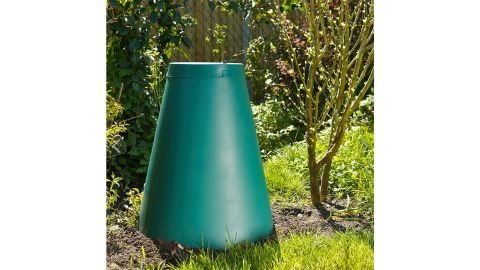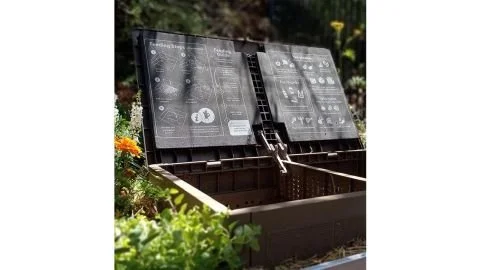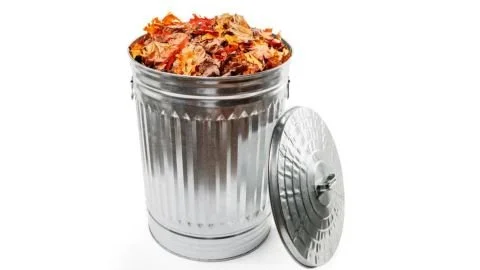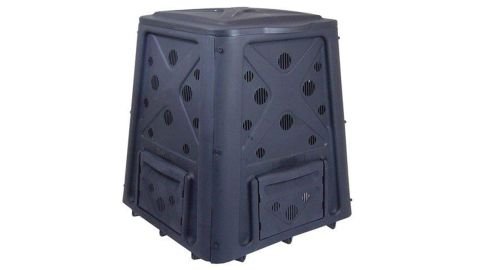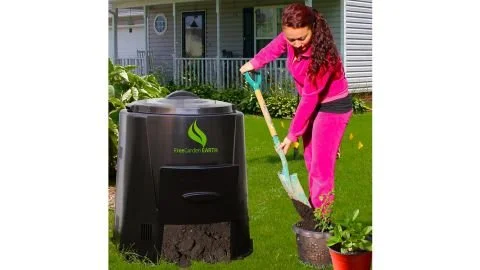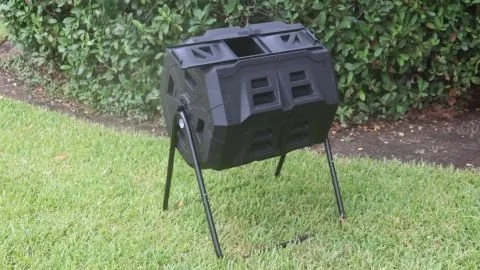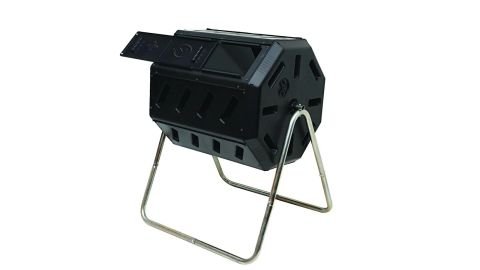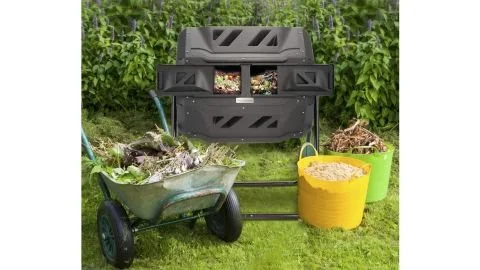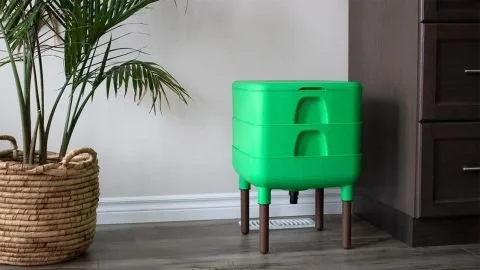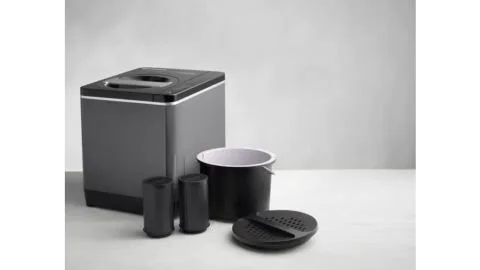Types of Composters
Types of composters
Now that you know the basics of composting, it’s time to figure out which system to use. To choose which compost method is best for you, the most important thing to do is figure out exactly what, and how much, you want to compost. Set your own expectations of what you want to do. Find a system that realistically matches with your waste stream and the level of effort that you want to put in.
In-ground compost
If you have access to outdoor space, you have plenty of options for compost. The first, and what is the easiest, is what’s called trench composting. To trench compost all you need to do is dig a deep hole, toss your food scraps in and cover it with 8 to 10 inches of soil.
A second and similar way is with a digester, which is basically a bin that’s partially underground and partially above ground. The part of the digester that’s below ground has holes so the soil’s ecosystem can break down your food scraps, but its lid on top keeps smells and pests away.
There’s some variance in digesters, as some use a design that uses the heat of the sun to help decomposition and others encourage you to add worms. While digesters are able to compost your waste without worms since they’re placed in the ground, adding the little critters can help speed up the process, but in general they aren’t necessary.
Both of these methods require less upkeep than other composting methods because they have access to the actual soil, which helps break down food with less maintenance. If you use a contained system like a vermicomposter or an elevated compost bin you’ll have to keep a closer eye on your ratio to ensure everything is composting smoothly.
Green Cone Solar Waste Digester ($249.99; eartheasy.com)
Green Cone Solar Waste Digester
Earth Easy
This digester lives partially in the ground, but its conical design helps heat up your food scraps to accelerate the decomposition process. if you go with a digester like this one, you might want to avoid adding worms because they won’t like the additional heat.
Subpod In-Garden Compost System ($214; subpod.com)
Subpod In-Garden Compost System
Subpod
This digester doesn’t channel the heat of the sun like the Green Cone does; instead, it relies on worms to break down your waste. It lives partially in the ground so the worms can come and go as they please, spreading the nutrients throughout the soil.
Tumbleweed Worm Feast In-Ground Worm Farm Composter ($41.19; homedepot.com)
Tumbleweed Worm Feast In-Ground Worm Farm Composter
The Home Depot
This digester also lives mostly underground and encourages you to add worms to accelerate decomposition. There’s a lot of digging at the outset, but once the bin is stationed in the ground, you can simply open the lid and add your greens and browns.
Behrens 31-Gallon Galvanized Steel Round Trash Can With Lid ($30.97; homedepot.com)
Behrens 31-Gallon Galvanized Steel Round Trash Can With Lid
The Home Depot
If you want to save money, you don’t have to actually buy a digester because you can make one yourself. Just drill holes into the bottom and lower third of a galvanized steel trash can, embed it into the ground and you have a composter.
On-ground compost bins
Yet another option is a compost bin that sits on top of the ground but still has holes in the bottom to help with drainage. It doesn’t have as much access to the natural soil, but since the bin is aboveground you can get a composter with multiple bins or even two separate ones if you need you to compost more at the same time.
This system is similar to the one many prefers, which is an open-air, DIY composter. The two main ways that I make a compost bin are with pallets that I pick up from going to waste or with hardware cloth/chicken wire. Simply put the three pallets together to make a U shape and then on the front fashion some sort of door to keep dogs out, such as wood slabs, chicken wire or another pallet. Or if you are using the hardware cloth/chicken wire method, use about 10 feet and tie it into a circle. Simple as that!
Everbilt 1-Inch-by-4-Foot-by-50-Foot Poultry Netting ($47.53; homedepot.com)
Everbilt 1-Inch x 4-Foot x 50-Foot Poultry Netting
The Home Depot
This 50-foot package of chicken wire is more than enough to build a simple, circular compost station.
Greenes 77.3-Gallon Cedar Wood Stationary Composter ($147.99; homedepot.com)
Greenes 77.3-Gallon Cedar Wood Stationary Composter
The Home Depot
If you don’t have spare pallets or want to build your own setup, this pre-built wooden composter is a great alternative.
Bosmere 100-Gallon Steel Wire Compost Bin ($68.39; homedepot.com)
Bosmere 100-Gallon Steel Wire Compost Bin
The Home Depot
This steel-wire compost bin is the same idea as a circle of chicken wire, but this one has a door so you can easily access the compost when you need to.
Redmon Since 1883 65-Gallon Compost Bin ($43.85, originally $79.99; amazon.com)
Redmon Since 1883 65-Gallon Compost Bin
Amazon
This bin sits on the ground and makes contact with your soil, so all you have to worry about is your ratio of greens, browns, air and water. It’s got a snap-on lid on top and four small doors on the bottom to remove the finished compost.
FreeGarden Earth 82-Gallon Enviro World Compost Bin ($95.76; homedepot.com)
FreeGarden Earth 82-Gallon Enviro World Compost Bin
The Home Depot
This compost bin features a twisting lid to make it harder for pets and pests to get in, along with an adjustable body to regulate airflow and metal grounding pegs to ensure it stays in one place. Plus, it has a big opening at the bottom so you can easily remove compost when it has fully broken down.
Taurus 65-Gallon Stationary Compost Bin and Turning Tool Combo Set ($78.78; homedepot.com)
Taurus 65-Gallon Stationary Compost Bin and Turning Tool Combo Set
The Home Depot
This stationary bin is similar to others, featuring a snap-on lid on top and four access doors on the bottom. This one comes with a compost turning tool to help you keep your pile properly aerated.
Elevated compost bins
The last of the outdoor options are elevated, completely above-ground containers that have their own bottom that doesn’t leach into the soil. The benefit of these is that they can go on your patios, on your rooftop, your balconies, . They can sit on surfaces and contain the composting process entirely within them, but there is usually a little bit more attention that needs to be paid to the balance of browns and greens and what you’re doing in there.
if you’re looking for a tumbler, you should consider a two-chambered one because they help a lot with harvesting. You can harvest one chamber while the other is still composting, which means you don’t have to sit and wait for one pile to completely compost before adding more food scraps.
Exaco 43-Gallon Mr. Spin Dual-Chamber Compost Tumbler ($88.14; homedepot.com)
Exaco 43-Gallon Mr. Spin Dual-Chamber Compost Tumbler
The Home Depot
This dual-chamber tumbler has a built-in thermometer so you can quickly and easily keep tabs on your pile’s progress. Plus, its sturdy base ensures it stays stable even when you’re spinning the compost to aerate it.
FCMP Outdoor Tumbling Composter With Two Chambers ($78.89; homedepot.com)
FCMP Outdoor Tumbling Composter With Two Chambers
The Home Depot
This tumbler also has two compartments so you can separate your new and old compost. Plus, it’s made from durable and UV-resistant plastic so it can withstand the elements.
Vivosun Outdoor Tumbling Composter Dual Rotating Batch Compost Bin ($89.99, originally $105.99; amazon.com)
Vivosun Outdoor Tumbling Composter Dual Rotating Batch Compost Bin
Amazon
This tumbler has two sliding doors leading to separate compartments, making adding organic waste and removing finished compost a breeze. This bin also comes with a pair of gardening gloves so you can keep your hands clean when you’re managing your pile.
Vermicompost
If you want an indoor system, the most common option is a worm bin, also known as vermicomposting, which is a contained ecosystem where you are sort of like the overlord of thousands of worms and you very carefully feed them portions of food scraps, . They live in a bedding of carbon-rich paper or cardboard, eat your food scraps and poop out nutrient- and microbially rich casting.
Portion control is critical to success when vermicomposting, . Oftentimes you’ll see statistics that composting worms can eat half their weight in scraps per day, but Louie warns that intake is at a worm’s peak performance, so you should start off slow with just a cup or two of food scraps, depending on how many worms you have. She recommends freezing the scraps, thawing them out again so you can drain the water, then feeding them to your worms. She says you should then wait for the food to be mostly gone before you feed again.
Worm Factory 360 ($131.95; amazon.com)
Worm Factory 360
Amazon
This large worm composter has four trays that can be expanded up to six. The worms will move up the trays to find more food, so as the bottom tray’s compost is finished, you can remove it and put it at the top of the stack, creating a loop system.
FCMP Outdoor Essential Living Composter ($89.99; homedepot.com)
FCMP Outdoor Essential Living Composter
The Home Depot
This 6-gallon option features three different levels and is available in four colors. Its small size makes it perfect for apartment composters.
Tumbleweed Can-O-Worms Compost Worm Farm Starter Kit ($113.85; homedepot.com)
Tumbleweed Can-O-Worms Compost Worm Farm Starter Kit
The Home Depot
This bin has two round trays where the worms can live and break down your food scraps. Plus, it has a ventilated lid to keep your worms happy and any flies or pests out.
Bokashi
Bokashi is a method that isn’t actually composting but rather a process of fermenting organic food waste in an airtight container. It’s a little different than other methods since normal composting is aerobic, but in short, bokashi uses a specific kind of fish flake to ferment food scraps in an airtight, anaerobic setting. The big difference between bokashi and normal compost is that you’re not done after you toss your food scraps into the bucket. With bokashi, once the waste is fermented you need to bury it in the ground so it can fully decompose. Although it’s a bit more work, bokashi is a great option because you can decompose all sorts of things that you wouldn’t be able to in normal compost like meat, bones, oils and candy.
I Kito 2-Gallon Food Grade Bucket With Easy Airtight Spin-Off and Spin-On Lid ($25; amazon.com)
I Kito 2-Gallon Food Grade Bucket With Easy Airtight Spin-Off and Spin-On Lid
Amazon
You can buy bokashi starter kits, but if you have a couple buckets and some time, you can easily make your own. Once that’s set up, simply add your food waste and bokashi flakes and let it work its magic.
All Seasons Bokashi Compost Starter (starting at $12.82; amazon.com)
All Seasons Bokashi Compost Starter
Amazon
All Seasons bokashi flakes are available in 1-, 2- and 3-gallon portions so you can stock up on your composting needs. While bokashi flakes are easy to find online, if you want to save some money you can make your own if you’re feeling adventurous enough.
Maze 2.1-Gallon Maze Bokashi Grain ($59.99; homedepot.com)
Maze 2.1-Gallon Maze Bokashi Grain
The Home Depot
Another option for bokashi flakes, this one from Maze comes in a 2.1-gallon bag.
Maze Airtight Bokashi Composter Kit ($69; homedepot.com)
Maze Airtight Bokashi Composter Kit
The Home Depot
This starter kit from Maze includes an airtight bin that features a built-in tap to drain any unnecessary liquid and a liquid bokashi starter spray.
All Seasons Indoor Composter Starter Kit ($56.95, originally $59.95; amazon.com)
All Seasons Indoor Composter Starter Kit
Amazon
This kit also features an airtight bucket and a bag of bokashi flakes.
Countertop machines
The last indoor options are countertop machines that rapidly dehydrate and churn your food scraps. They are expensive and depending on the machine you get, the final product might not actually be compost but rather a shrunken, dried-out version of your food that can then be put into a composter or sprinkled into your garden.
Vitamix FoodCycler FC-50 ($349.95, originally $399.99; vitamix.com)
Vitamix FoodCycler FC-50
Vitamix
The Vitamix FoodCycler rapidly dehydrates and chops up your food scraps to turn it into a recycled food compound. While this mixture isn’t quite compost, you can mix it into soil to turn it into a nutrient-rich fertilizer. This machine takes up only 1 cubic foot of space and can be run multiple times per day.
Lomi Kitchen Composter ($499; pela.earth.com)
Lomi Kitchen Composter
Pela
The Lomi — created by Pela, which makes compostable tech accessories — is similar to the Vitamix FoodCycler; however, it has a special grow mode that takes over 20 hours but turns your food scraps into a more mature, nutrient-dense soil that you can add directly to your plants and garden. Plus, the Lomi is designed to break down certain bioplastics, such as Pela phone cases, which isn’t normally possible with at-home compost systems.
